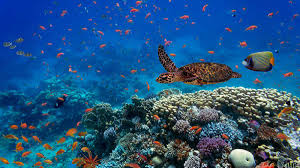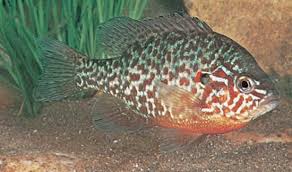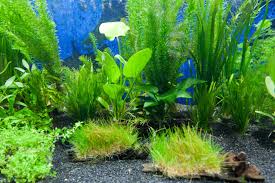Aquatic plants grow in and around the rock pools and slow channels of the river. Some are rooted in mud or cracks in the rocks; others float on, or near, the water surface. They tend to be soft, fleshy, and easily torn. The first step toward the correct identification of an aquatic plant is to observe how it is growing in the water.
Understanding the growth habit will also help determine the best method and timing for control, if necessary. Some species may exhibit different growth forms in response to their environment.
Furthermore, a plant’s growth form may change during its life cycle. Invertebrate fauna are a vital part of the freshwater ecosystem. They include grazers, plant shredders, filterers, and predators. Many of them feed on plant matter (algae, leaf litter, and aquatic “weeds”) and in turn, provide the most important food source to almost all freshwater fish.
Read Also: All You Need To Know About Small White Flowers
Different Flora in the Fisheries Ecosystem

1. Canna spp. Characteristics
- Ornamental, growing tall with showy flowers.
- Large oval leaves pointing upward.
- Usually growing in small clusters limited to the shoreline.
2. Cephalanthus occidentalis (Buttonbush) Characteristics
- Woody, aquatic shrub with oval leaves coming to a point.
- Loose clusters of round seed heads approximately 3⁄4 inch in diameter.
- Grows in shallow water, often out from the shoreline.
3. Colocasia esculenta (Wild Taro) Characteristics
- Arrowhead-shaped terminal leaf up to 2 feet long.
- 3 primary leaf veins stretching to each lobe, several secondary veins along the primary veins that are nearly opposite.
- To separate amongst other plants with arrowhead-shaped leaves, Colocasia esculenta leaves are peltate.
4. Cuscuta spp. (Dodder) Characteristics
- Parasitic, aquatic vine found growing on other emergent plants.
- Stems yellow to orange.
- Occasional tiny white flowers along the stem.
5. Echinodorus cordifolius (Creeping Burhead) Characteristics
- Leaves spade-shaped, with a shallow cleft at the petiole.
- Petioles are grooved with 3 to 5 primary veins.
- Flowers are on short stalks whorled around a leafless stalk.
6. Eriocaulon spp. (Hatpins) Characteristics
- Thin rush with small terminal inflorescence resembling small cotton balls.
- Rush loosely fanning in all directions, grows in moist soil or very shallow water.
7. Hydrocotyle spp. (Water Pennywort) Characteristics
- Each stem has a single terminal leaf that is nearly round with a shallow cleft.
- Stem attaches to the center of the leaf.
- Found along shorelines in moist soil or very shallow water, can form floating mats of tangled stems.
8. Hydrolea quadrivalvis (Waterpod) Characteristics
- Leaves alternate with rough margins.
- Stiff thorns and blue flowers in the leaf axis.
- Grows in isolated clumps but can eventually surround the shoreline.
9. Hygrophila costata (Lake Hygrophila) Characteristics
- Leaves are arranged oppositely around the stem.
- Small, white to pink flowers in the leaf axis.
- Stems have rough margins and fine hairs, typically grows in isolated clumps along the shoreline.
10. Hymenocallis spp. (Spider Lily) Characteristics
- Showy, white flowers in groups at the end of a thick, leafless stem.
- Grows in moist soil to shallow water.
11. Justicia americana (Waterwillow) Characteristics
- Long, narrow leaves arranged oppositely along the stem.
- Faint purple, irregular flowers.
- Spreads by rhizomes and grows out from shorelines in deeper water.
12. Limnobium spongia (Frog’s Bit) Characteristics
- Leaves spade-shaped, often curled upward on the sides.
- Forms thick mats growing out from shorelines.
- Plant has feathery white roots, small floating leaves are heart-shaped.
13. Ludwigia peploides (Water Primrose) Characteristics
- Leaves arranged alternately around a thick, hollow stem that is green to red.
- Flowers yellow, rooted along shorelines but forms floating mats.
14. Luziola fluitans (Southern Water Grass) Characteristics
- Leaf blades 3 to 5 inches long, lying flat on the surface or raised a few inches high.
- Rooted at the shoreline, forms floating mats that creep out from shore.
15. Marsilea spp. (Water Clover) Characteristics
- Resembles a 4-leaf clover.
- Can grow erect on long stalks or in slightly deeper water with floating leaves.
- Usually found in moist soil or very shallow water.
16. Green Algae in Fisheries Ecosystems
- Free-floating in the water column, the water appears green.
- Directly related to water fertility and fish productivity.
17. Euglena spp. (Euglena) Characteristics
- Unicellular organisms with characteristics of both plants and animals.
- Forms a rusty brown or green skim on the surface, associated with ponds with high organic nutrient input.
18. Blue-green Algae Characteristics
- Forms a skim on the water surface, ranging from light green to blue or even white.
- Typically found in fertile ponds, often with a foul sulfur odor.
Read Also: Recommended Volume of Water for Fish Farming on a Concrete Pond
Fauna in the Fisheries Ecosystem

Freshwater invertebrates, including insects, crustaceans, snails, worms, and others, play essential roles in the aquatic ecosystem.
1. Procedure for Observing Protozoans
- Protozoans are unicellular organisms, most of which are microscopic. They can be found in streams, ponds, oceans, and moist soil.
i. Preparation of slides: Place a drop of pond water on a slide, cover it gently with a cover slip to avoid air bubbles, and observe under a microscope.
2. Sampling Invertebrates
- Select easy and safe sites for sampling invertebrates, especially in shallow, fast-flowing areas called riffles.
- Invertebrates are picked or scraped from rocks and placed in a container for identification.
3. Common Fauna in Freshwater Ecosystems
1. Ameletopsis: A rare mayfly larvae, a good indicator of clean water.
2. Zelandoperla: A large stonefly larvae that prefer high-quality waters.
3. Freshwater Shrimps: Crustaceans that tolerate nutrient-enriched waters.
4. Helice Mud Crabs: Crustaceans abundant in muddy estuaries.
5. Potamopyrgus: A widespread pond snail tolerant of various water conditions.
6. Oligochaete Worms: Found in both pristine and polluted waters.
Invertebrates can indicate the “state of health” of water bodies. The presence of many species points to clean water and natural conditions, while the absence of invertebrate life may signal pollution or low flow conditions.
Do you have any questions, suggestions, or contributions? If so, please feel free to use the comment box below to share your thoughts. We also encourage you to kindly share this information with others who might benefit from it. Since we can’t reach everyone at once, we truly appreciate your help in spreading the word. Thank you so much for your support and for sharing!
Read Also: How Art Teachers Foster Creative Expression

